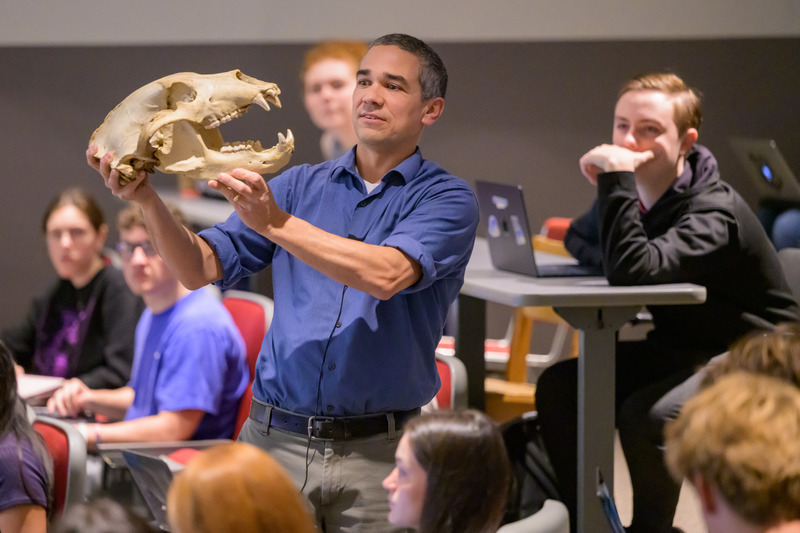


How I Teach — Wildlife Conservation and Ecology
Photo by Evan Krape December 22, 2023
UD students get up close with wildlife in Prof. Kyle McCarthy’s introductory conservation course
Editor’s Note: First-year students, prospective students (and some of their parents) wonder and worry how they will handle the academic transition from high school to college. In a series of stories, UDaily speaks with University of Delaware professors who teach courses commonly taken by students during their first year on campus. The series includes professors who teach biology, writing, business, calculus, political science and sociology, and those stories can be read on the How I Teach website. In this story, wildlife ecology professor Kyle McCarthy explains how he teaches wildlife conservation and ecology.
Kyle McCarthy likes to spice up his lectures.
The University of Delaware associate professor of wildlife ecology, who teaches Wildlife Conservation and Ecology (ENWC 201) to first-year students, will sometimes bring in an animal skull and pass it around his classroom. One day it’s an alligator skull; the next class it’s a badger pelt or bear skull.
Then he’ll poll his students.
“I ask them, ‘What do they think it is?’” McCarthy said. “And why do they think that? And what do they think its role in its ecosystem is?”
As an animal skull or pelt circulates his classroom of some 250 students, McCarthy dives into predator-prey interactions or how these animals have adapted to their environments. On other days, McCarthy might bring in a taxidermy owl or show a video about how lions and cape buffalo interact in Africa. As the Department of Entomology and Wildlife Ecology undergraduate program coordinator, he brings a lot of enthusiasm to the subject and takes nature to the classroom when he can’t bring his often-large class out into nature.
“I truly try to teach with a lot of passion,” McCarthy said. “I think it’s an easy subject to be passionate about.”
McCarthy’s students also work through a series of documents and videos that he filmed while traveling around the U.S. and Central America. Students also examine images captured by camera traps placed in Brazil that give them insight into jaguar conservation and sustainable cattle ranching. Then they take quizzes about those conservation issues.
In 2018, McCarthy received UD’s Excellence in Teaching Award, UD’s highest award for teaching. The honor recognized him for outstanding work in teaching and advising.
ENWC 201 is required for all Blue Hens pursuing a major or minor in wildlife ecology and conservation. Students get an introduction into biological diversity, the threats to wildlife and their ecosystems, and how to address those threats.
Students from any major across UD can enroll in ENWC 201 as an optional course to fulfill the mathematics, science or technology breadth requirement. McCarthy teaches all sorts of students, from wildlife to business to fashion design.
“It’s a diversity of students, a diversity of backgrounds, and a diversity of opinions and thoughts, which is actually really wonderful,” McCarthy said. “It’s a chance to work with and reach so many different students.”
ENWC 201 is not a difficult course, McCarthy said, but it’s a bit different from what many students are used to. Instead of a formula-based science, like chemistry or physics, Wildlife Conservation and Ecology challenges students with complex terms and definitions as well as how to think about wildlife interactions in nature.
Students gain a new and deeper understanding of how important biodiversity is for humans and the planet. McCarthy teaches students where wildlife and wildlife conservation fits in, but also wants them to learn accountability.
“I’m not going to take attendance of 250 students in my class every day,” McCarthy said, “and I’m not going to know whether they’re there or not. So that accountability is up to them.”
McCarthy said he often sees first-year students struggle with the transition from high school to college. He’ll talk with students about how they are now in charge of their own learning experiences.
“I really try to help students understand that to do well, they need to show up and they need to be interested,” McCarthy said. “And whether it’s my class or whether it's another class that they’re struggling with, really start to try and invest in the content and understand it and be interested in it and they’ll do so much better at it.”
But with a subject that is so easy to love, McCarthy’s students often do well in this course. McCarthy said he has been really impressed with his students since he started teaching at UD in 2011.
“We have an amazing student body, and it makes it a joy to teach here,” McCarthy said. “Even in that class with 250 students, there's so much engagement, so much interest, and they're so bright. And I think that makes it a joy, from my end, to be a professor at the University, too.”
Contact Us
Have a UDaily story idea?
Contact us at ocm@udel.edu
Members of the press
Contact us at 302-831-NEWS or visit the Media Relations website

